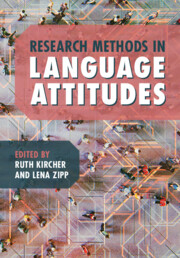Book contents
- Research Methods in Language Attitudes
- Research Methods in Language Attitudes
- Copyright page
- Contents
- Figures
- Tables
- Contributors
- Foreword
- Acknowledgements
- 1 An Introduction to Language Attitudes Research
- Part 1 Analysis of the Societal Treatment of Language
- 2 Discourse Analysis of Print Media
- 3 Content Analysis of Social Media
- 4 Discourse Analysis of Spoken Interaction
- 5 Analysis of Communication Accommodation
- 6 Variable Analysis
- Part 2 Direct Methods of Attitude Elicitation
- Part 3 Indirect Methods of Attitude Elicitation
- Part 4 Overarching Issues in Language Attitudes Research
- References
- Index
- References
5 - Analysis of Communication Accommodation
from Part 1 - Analysis of the Societal Treatment of Language
Published online by Cambridge University Press: 25 June 2022
- Research Methods in Language Attitudes
- Research Methods in Language Attitudes
- Copyright page
- Contents
- Figures
- Tables
- Contributors
- Foreword
- Acknowledgements
- 1 An Introduction to Language Attitudes Research
- Part 1 Analysis of the Societal Treatment of Language
- 2 Discourse Analysis of Print Media
- 3 Content Analysis of Social Media
- 4 Discourse Analysis of Spoken Interaction
- 5 Analysis of Communication Accommodation
- 6 Variable Analysis
- Part 2 Direct Methods of Attitude Elicitation
- Part 3 Indirect Methods of Attitude Elicitation
- Part 4 Overarching Issues in Language Attitudes Research
- References
- Index
- References
Summary
Whenever two or more people meet and begin to communicate, subtle or not-so-subtle changes in speech patterns may emerge as a result – including switches to a different language, shifts in pronunciation, speech rate and utterance lengths, as well as non-verbal behaviours. Communication Accommodation Theory deals with interlocutors’ motivations for becoming linguistically more alike or less alike as well as their motivations for not changing their speech at all. As conation constitutes one of the components of language attitudes, these communicative strategies are considered to reflect – at least to a certain extent – the attitudes that interlocutors hold towards each other and their respective social groups. This chapter discusses how analysing communication accommodation as an indicator of language attitudes comes with both strengths (e.g. it reflects actual language use in daily communicative practice) and limitations (e.g. the remaining uncertainty of how affect and conation interact). Key practical issues of planning and research design are addressed, such as the all-important mitigation of the observer’s paradox, which may, by itself, trigger accommodation. The chapter then discusses the analysis of data resulting from communication accommodation studies. It concludes with a case study of communication accommodation between French and English speakers in Quebec’s urban centre, Montreal.
Keywords
- Type
- Chapter
- Information
- Research Methods in Language Attitudes , pp. 66 - 78Publisher: Cambridge University PressPrint publication year: 2022

